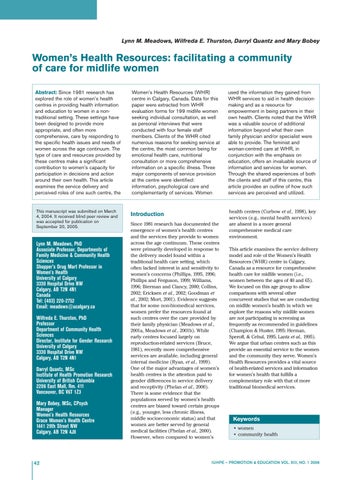Lynn M. Meadows, Wilfreda E. Thurston, Darryl Quantz and Mary Bobey
Women’s Health Resources: facilitating a community of care for midlife women Abstract: Since 1981 research has explored the role of women’s health centres in providing health information and education to women in a nontraditional setting. These settings have been designed to provide more appropriate, and often more comprehensive, care by responding to the specific health issues and needs of women across the age continuum. The type of care and resources provided by these centres make a significant contribution to women’s capacity for participation in decisions and action around their own health. This article examines the service delivery and perceived roles of one such centre, the
This manuscript was submitted on March 4, 2004. It received blind peer review and was accepted for publication on September 20, 2005.
Lynn M. Meadows, PhD Associate Professor, Departments of Family Medicine & Community Health Sciences Shopper’s Drug Mart Professor in Women’s Health University of Calgary 3330 Hospital Drive NW Calgary, AB T2N 4N1 Canada Tel: (403) 220-2752 Email: meadows@ucalgary.ca Wilfreda E. Thurston, PhD Professor Department of Community Health Sciences Director, Institute for Gender Research University of Calgary 3330 Hospital Drive NW Calgary, AB T2N 4N1 Darryl Quantz, MSc Institute of Health Promotion Research University of British Columbia 2206 East Mall, Rm. 411 Vancouver, BC V6T 1Z3 Mary Bobey, MSc, CPsych Manager Women’s Health Resources Grace Women’s Health Centre 1441 29th Street NW Calgary, AB T2N 4J8
42
Women’s Health Resources (WHR) centre in Calgary, Canada. Data for this paper were extracted from WHR evaluation forms for 199 midlife women seeking individual consultation, as well as personal interviews that were conducted with four female staff members. Clients of the WHR cited numerous reasons for seeking service at the centre, the most common being for emotional health care, nutritional consultation or more comprehensive information on a specific illness. Three major components of service provision at the centre were identified: information, psychological care and complementarity of services. Women
used the information they gained from WHR services to aid in health decisionmaking and as a resource for empowerment in being partners in their own health. Clients noted that the WHR was a valuable source of additional information beyond what their own family physician and/or specialist were able to provide. The feminist and woman-centred care at WHR, in conjunction with the emphasis on education, offers an invaluable source of information and services for women. Through the shared experiences of both the clients and staff of this centre, this article provides an outline of how such services are perceived and utilized.
Introduction
health centres (Curbow et al., 1998), key services (e.g., mental health services) are absent in a more general comprehensive medical care environment.
Since 1981 research has documented the emergence of women’s health centres and the services they provide to women across the age continuum. These centres were primarily developed in response to the delivery model found within a traditional health care setting, which often lacked interest in and sensitivity to women’s concerns (Phillips, 1995, 1996; Phillips and Ferguson, 1999; Williams, 1996; Bierman and Clancy, 2000; Collins, 2002; Ericksen et al., 2002; Goodman et al., 2002; Mort, 2001). Evidence suggests that for some non-biomedical services, women prefer the resources found at such centres over the care provided by their family physician (Meadows et al., 2001a, Meadows et al., 2001b). While early centres focused largely on reproduction-related services (Bruce, 1981), recently more comprehensive services are available, including general internal medicine (Ryan, et al., 1999). One of the major advantages of women’s health centres is the attention paid to gender differences in service delivery and receptivity (Phelan et al., 2000). There is some evidence that the populations served by women’s health centres are biased toward certain groups (e.g., younger, less chronic illness, middle socioeconomic status) and that women are better served by general medical facilities (Phelan et al., 2000). However, when compared to women’s
This article examines the service delivery model and role of the Women’s Health Resources (WHR) centre in Calgary, Canada as a resource for comprehensive health care for midlife women (i.e., women between the ages of 40 and 65). We focused on this age group to allow comparisons with several other concurrent studies that we are conducting on midlife women’s health in which we explore the reasons why midlife women are not participating in screening as frequently as recommended in guidelines (Champion & Huster, 1995; Herman, Speroff, & Cebul, 1995; Lantz et al., 1995). We argue that urban centres such as this provide an essential service to the women and the community they serve. Women’s Health Resources provides a vital source of health-related services and information for women’s health that fulfills a complementary role with that of more traditional biomedical services.
Keywords • women • community health
IUHPE – PROMOTION & EDUCATION VOL. XIII, NO. 1 2006







